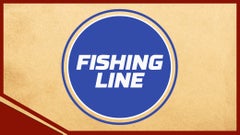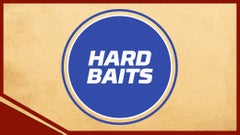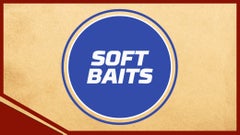FLW Potomac River Baits, Gear & Patterns
Scott Martin's Winning Pattern, Baits & Gear
The fifth Tour win of his career moved him up to 2nd in the Angler of the Year (AOY) race and 5th in the BassFan World Rankings. It marked his fifth finish of 17th or better in eight outings dating back to his Cup triumph last August. There's far less aquatic grass than usual dotting the Potomac right now, but Martin nonetheless felt that the winner on the tidal fishery would emerge from the milfoil beds. "After being there last year, I saw that I was going to have to be in the grass to do well, and obviously grass is what I enjoy fishing the most," he said. "I focused on some of the big flats and thought that the cold weather they'd had several weeks ago might have held some of the fish back a little bit, and that the schools of bigger fish would be in the grassbeds.
"I picked out two areas that had good concentrations of fish that I knew would be fished by a lot of people, then I also wanted to find a few places off the beaten path that I could hit at optimal times during the day and catch a few key fish."
Competition:
The 145-angler field encountered the highest tide of the day during the initial hours, and Martin elected to begin each day on a bed to the north of the launch in National Harbor, Md. He primarily threw moving baits there. As the tide fell, he'd relocate about 20 miles to the south and pull out a flipping stick. "For flipping grass, I like the last 2 hours of low tide and the first 2 hours of incoming," he said. "Some people like it higher, but for me, it's easier to anticipate where the fish are going to be when it's low. When it's high, they seem to spread out a little more."
He had about 16 pounds in his livewell when he went south on day 1 and managed to cull up by more than 6 pounds during the remainder of the day to compile a massive sack that was the best of the tournament by far. A couple of his best fish came from the northern locale. "I was boat (No.) 141 the first day and by the time I got there, there were 20 other tournament anglers in the area. I stopped on the outside, which is where I wanted to fish anyway, and in hindsight, all those people being there worked to my advantage.
"If I'd gotten there first, then they would've been stopping outside of me, but I think all the pressure in there and the noise of the trolling motors and livewells and depthfinders pushed some of the fish out. I caught that 5-11 on the outside, then I circled all the way around to the other side of the armada and caught another 5-pounder." He made his jaunt to the south at about 11:00 that day. On day 2 he waited until noon, and he left at 9:00 on each of the final 2 days. The southern areas, in the vicinity of Aquia Creek and Potomac Creek, featured much thicker grass. He had success there flipping a Bruiser Baits Paddle Tail.
"I couldn't get bites on that up north, but for flipping, it was great," he said. "I caught a lot of fish down there doing that." In his northern locale, he threw a ChatterBait with a Bruiser Baits Crazy Craw trailer and then would "mop up" afterward with a Bruiser Baits Stick Worm. He said his weigh-in fish were split roughly half and half between the northern and southern locales.
Winning Gear:
ChatterBait gear: 7' medium-heavy Okuma Helios rod, Okuma Helios casting reel (6.3:1 ratio), 17-pound XPS fluorocarbon line, 1/2-ounce Z-Man ChatterBait (black/blue), Bruiser Baits Crazy Craw trailer (black/blue).
Worm gear: Same rod and reel, 12-pound XPS fluorocarbon, 1/8-ounce River2Sea tungsten weight, 4/0 Lazer TroKar straight-shank worm hook with plastic baitkeeper, 5" Bruiser Baits Stick Worm (black/blue or watermelon-red).
He said the straight-shank hook was important because it allowed the hook to stay clean. "A hook with a 90-degree bend would've been picking up a bunch of that black moss off the bottom."
Flipping gear: 7'6" heavy-action Okuma Helios flipping stick, Okuma Komodo casting reel (7.3:1 ratio), 17-pound XPS fluorocarbon, 3/16- or 1/4-ounce River2Sea tungsten weight, 3/0 straight-shank Lazer TroKar flipping hook, Bruiser Baits Paddle Tail (junebug).
"The River2Sea weights are wider around than other brands of that size I've used in the past," he said. "They matched the diameter of the bait perfectly and there wasn't a big hunk of plastic sticking out around the outside of it, and that make it more weedless."
He added that the sensitivity of the Okuma rods played a big role in detecting extremely light bites and that his Zeko shoes kept his feet comfortable throughout the long tournament days. "That might sound corny, but it's important when you're on your feet trying to grind it out every day. If your feet aren't comfortable, then your back can start hurting."
Main factor: "Paying attention to the pressure in my areas and making adjustments accordingly. Whether it was locals or tournament anglers, a lot of guys would Power-Pole down and stay on their own little 10-yard stretch all day. I moved around and paid attention to the pressure, and I got two of my big fish on the first day because of that."
Performance edge: "The GPS in my Garmin electronics is so accurate that I could save a waypoint in a high-water spot where I couldn't see the grass, but I could tell it was a little thicker there because I could feel it with the ChatterBait. Also, the twin Power-Poles allowed me to stay in perfect position to cast, and I know that resulted in several extra fish."
Justin Lucas' Pattern, Baits & Gear
His big sack on day 2 came from the grass in Mattawoman Creek after he'd wisely abandoned his day-1 area. He was crowded out of the Mattawoman locale by a local tournament on day 3, so he spent the final 2 days in a small bay just off the main channel that saw relatively light pressure during the event. "I don't even know the name of the area," he said. "It's just a 1/2- to 3/4-mile stretch (of grass). I know it got fished, but a lot of people overlooked it." He got most of his fish pitching a Berkley Havoc Pit Boss and picked up a few on a swimjig and a soft stickbait.
Flipping gear: 7'6" medium-heavy Powell 765 CB rod, Abu Garcia Revo SX casting reel (7.1:1 ratio), 30- or 50-pound Spiderwire Ultracast braid (main line), 15-, 17- or 20-pound Berkley Trilene 100% fluorocarbon leader (2'), unnamed 1/4- or 3/8-ounce weight, 4/0 straight-shank Owner hook, Berkley Havoc Pit Boss (Okeechobee craw).
Swimjig gear: Same rod and reel, 15-pound Trilene 100%, 1/4-ounce 4x4 swimjig (Okeechobee craw), Berkley Havoc Grass Pig trailer (green-pumpkin).
He shortened the Grass Pig by cutting off part of the head and also dipped the tail in chartreuse dye.
Main factor: "It was definitely on day 2 when I left the area I'd fished on day 1 and went and found new water."
Performance edge: "That Powell rod. It's not real stiff and it has a parabolic action. I had four of them and I could use them to throw anything I wanted."
David Dudley's Pattern, Baits & Gear
"I think a few of my fish were spawners, but I'd venture to say that most of them had already spawned," he said. "Probably 75 percent of them looked that way. "They live in those places Ð they don't go anywhere. They go through their whole year-cycle in the same grassbed. His approach consisted of a combination of throwing a bladed jig and flipping.
Jig gear: 7'3" medium-heavy Abu Garcia Verdict rod, Abu Garcia Revo Premier casting reel, 20-pound Berkley Trilene 100% fluorocarbon line, 1/2-ounce unnamed bladed jig (green-pumpkin/orange), Berkley Havoc Rocket Craw trailer (perfection green fleck).
Flipping gear: 7'11" heavy-action Abu Garcia Veritas rod, Abu Garcia Revo MGX casting reel (7.9:1 ratio), same line, unnamed 1/2-ounce weight, unnamed 5/0 hook, Berkley Havoc Pit Boss (big Texan).
Main factor: "You've got to be mentally tough on these kinds of fisheries to make the right decisions on the water."
Performance edge: "Having the Rocket Craw on the back of my bladed jig was key. It allowed me to go through high-pressured areas and outfish people who'd been there before me."
Jim Moynagh's Pattern, Baits & Gear
"I quit wasting time in places where the upside was a 3 1/2-pounder Ð I wanted the upside to be 6-pounders. That wasn't a whole lot of water and I really picked it apart. "Success in this sport is the accumulation of many small details. On day 1 I caught all of my weight on a swimming worm, and then on day 2 it changed to more of a jig bite. I learned that by watching my co-angler, who was catching an equal number of fish as me, but bigger ones. I caught a couple of good ones that day, and then I fished the jig 75 percent of the time on day 3 and day 4."
Jig gear: 7' heavy-action unnamed rod, unnamed casting reel (7:1 ratio), unnamed 12-pound fluorocarbon line, 3/8-ounce All-Terrain Tackle swimjig (black/purple/green), unnamed grub trailer (junebug).
Worm gear: Same rod and line, unnamed casting reel (6.4:1 ratio), 4/0 unnamed weighted hook, unnamed swimming worm (black, junebug or smoke).
Main factor: "Fishing the jig most of the time on the last 2 days."
Performance edge: "I'd say having the automatic anchors. For shallow grass-fishing they're important because they allow you to settle into an area without making a whole lot of commotion."
Colby Schrumpf's Pattern, Baits & Gear
"The deeper water was 6 feet and the fish were in anywhere from 1 to 3 feet, and they moved with the tides. Low tide was definitely better Ð that's when I caught my bigger fish." A Zoom finesse worm enticed the majority of his bites, which were frequent (he averaged about 25 keepers per day).
Worm gear: 6'10" medium-heavy G. Loomis 803 rod, Quantum Tour KVD casting reel, 12-pound Berkley Vanish fluorocarbon line, 3/16-ounce Gamakatsu shakey-head jig, Zoom Finesse Worm (green-pumpkin).
He caught a few dock fish on day 2 on a 5/16-ounce Jewel Eakins jig (black/blue) with a Zoom craw trailer (black/blue).
Main factor: "Basically having my area to myself."
Performance edge: "I caught a lot of fish, so it was probably a culling beam."
Potomac River Winning Pattern Bassfan 5/22/12 (John Johnson)
Potomac River Patterns 2-5 Bassfan 5/22/12 (John Johnson)




















